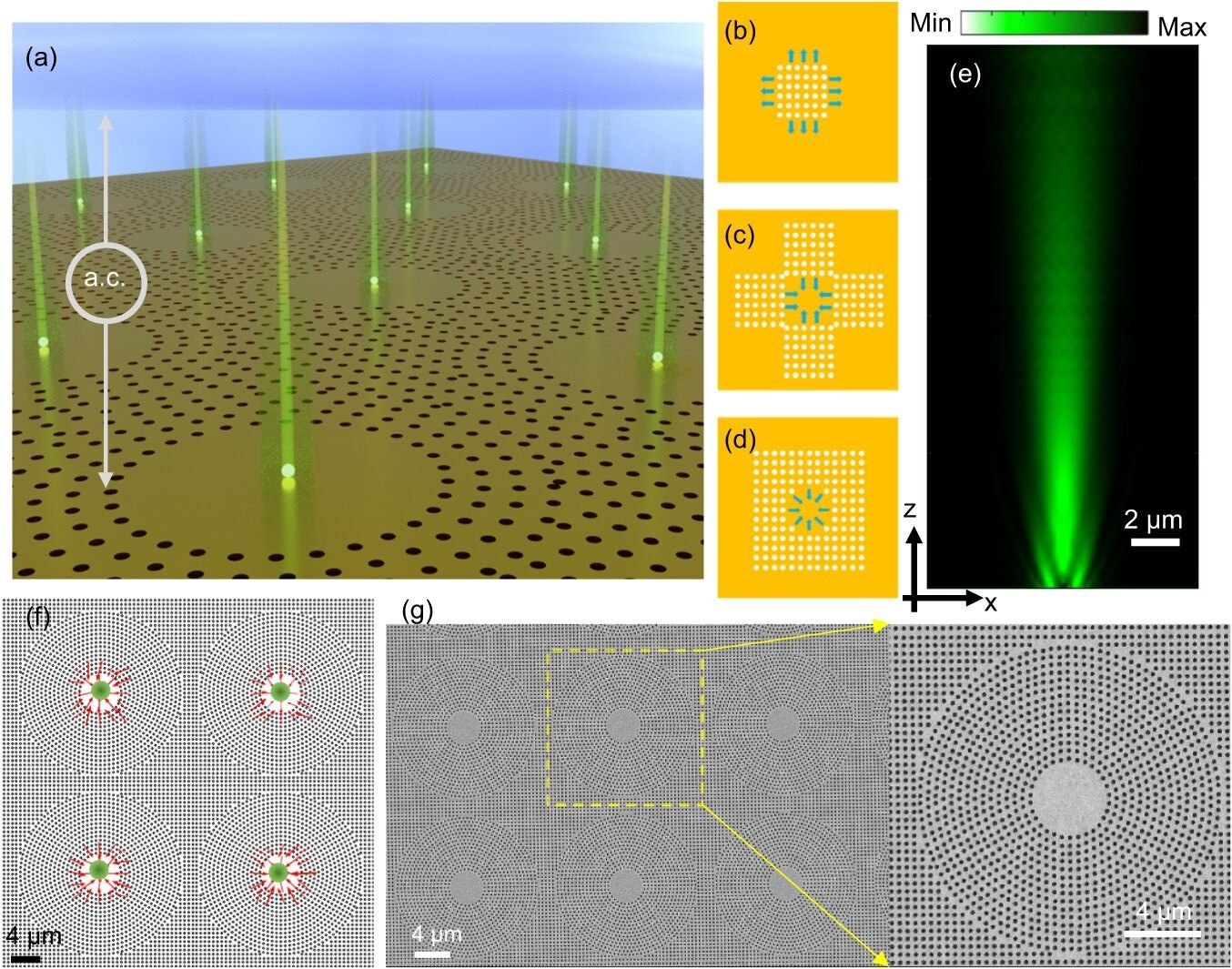Vanderbilt researchers have developed a way to more quickly and precisely trap nanoscale objects such as potentially cancerous extracellular vesicles using cutting-edge plasmonic nanotweezers.
 Illustration and theoretical analysis of the GET system. a Illustration of the operating mechanism of the GET system. The tangential a.c. field induces electro-osmotic flow that is radially outward. By harnessing a circular geometry with a void region, the radially outward a.c. electro-osmotic flow creates a stagnation zone at the center of the void region where trapping takes place. b A square-lattice nanohole array generates a.c. electro-osmotic flow outwards. c Four square lattice arrays create a.c. electro-osmotic flows converging to the center. d A radial-lattice nanohole array generates a.c. electro-osmotic flows converging to the center of the void region. b–d illustrate the evolution from a square-lattice nanohole array into a radial-lattice nanohole array. e Radiation energy flow for a dipole fluorescence emitter placed at the center of the void region showing the ability to harness the GET trap to also beam emitted photons from trapped particles. f COMSOL simulation of the radial electro-osmotic flow showing that the geometry of the void region results in opposing electro-osmotic flow that forms a stagnation zone at the center. Particle trapping occurs at the center of the void region where the flow vectors converge. The particle trapping position is highlighted with green dots, g SEM image of the plasmonic metasurface array with void regions, and a zoomed-in version of an individual GET trap. Each void region represents a GET trap and can be readily scaled from hundreds to thousands or millions as desired. Image Credit: Nature Communications (2023). DOI: 10.1038/s41467-023-40549-7
Illustration and theoretical analysis of the GET system. a Illustration of the operating mechanism of the GET system. The tangential a.c. field induces electro-osmotic flow that is radially outward. By harnessing a circular geometry with a void region, the radially outward a.c. electro-osmotic flow creates a stagnation zone at the center of the void region where trapping takes place. b A square-lattice nanohole array generates a.c. electro-osmotic flow outwards. c Four square lattice arrays create a.c. electro-osmotic flows converging to the center. d A radial-lattice nanohole array generates a.c. electro-osmotic flows converging to the center of the void region. b–d illustrate the evolution from a square-lattice nanohole array into a radial-lattice nanohole array. e Radiation energy flow for a dipole fluorescence emitter placed at the center of the void region showing the ability to harness the GET trap to also beam emitted photons from trapped particles. f COMSOL simulation of the radial electro-osmotic flow showing that the geometry of the void region results in opposing electro-osmotic flow that forms a stagnation zone at the center. Particle trapping occurs at the center of the void region where the flow vectors converge. The particle trapping position is highlighted with green dots, g SEM image of the plasmonic metasurface array with void regions, and a zoomed-in version of an individual GET trap. Each void region represents a GET trap and can be readily scaled from hundreds to thousands or millions as desired. Image Credit: Nature Communications (2023). DOI: 10.1038/s41467-023-40549-7
The practice by Justus Ndukaife, assistant professor of electrical engineering, and Chuchuan Hong, a recently graduated Ph.D. student from the Ndukaife Research Group, and currently a postdoctoral research fellow at Northwestern University, has been published in Nature Communications.
Optical tweezers, as acknowledged with a 2018 Physics Nobel Prize, have proven adept at manipulating micron-scale matter like biological cells. But their effectiveness wanes when dealing with nanoscale objects. This limitation arises from the diffraction limit of light that precludes focusing of light to the nanoscale.
A breakthrough concept in nanoscience, called plasmonics, is being used to surpass the diffraction limit and confine light to the nanoscale. However, trapping the nanoscale objects near plasmonic structures can be a lengthy process because of the wait for nanoparticles to randomly approach the structures.
But Ndukaife and Hong have provided a speedier solution with the introduction of a high-throughput plasmonic nanotweezer technology termed "Geometry-induced Electrohydrodynamic Tweezers" (GET), which enables the rapid and parallel trapping and positioning of single nanoscale biological objects like extracellular vesicles near plasmonic cavities in a matter of seconds without any harmful heating effects.
"This achievement … marks a significant scientific milestone and charts a new era for optical trapping at the nanoscale using plasmonics," says Ndukaife. "The technology may be used to trap and analyze single extracellular vesicles with high throughput to understand their fundamental roles in diseases such as cancer."
Ndukaife recently had a paper published in Nano Letters that discusses using optical anapoles to more effectively trap nanosized extracellular vesicles and particles to analyze their roles in cancer, and neurodegenerative diseases.